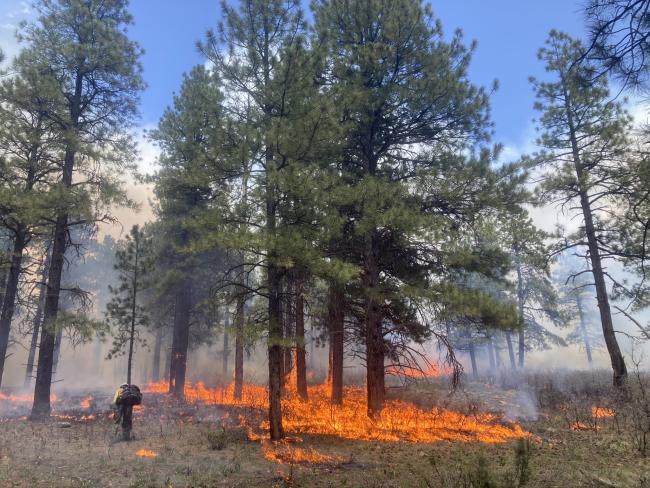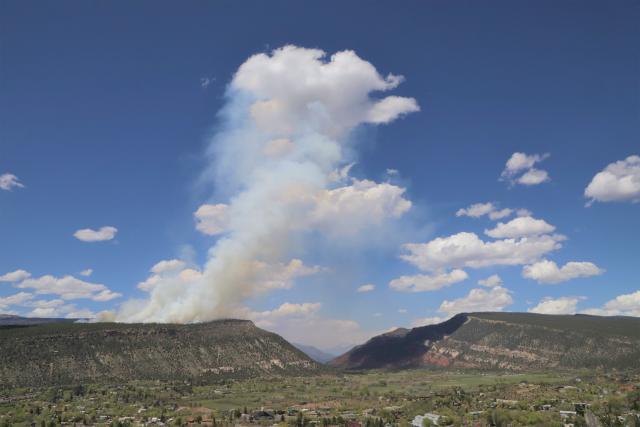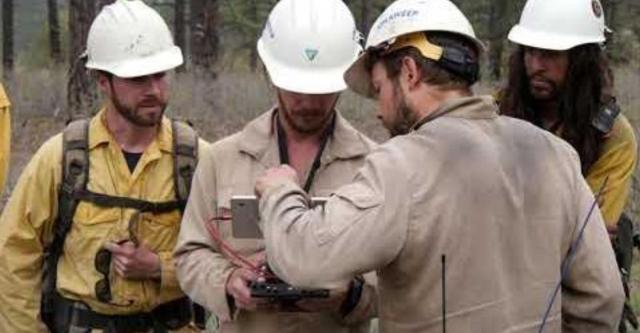Bipartisan Infrastructure Law - Animas City Mountain Rx burn
Listen
Subscribe
In 2023, after years of planning between BLM, the Forest Service, and state and local agencies, interagency crews ignited the Animas City Mountain prescribed burn. In this interview, James Savage, a supervisory fire management officer with BLM, talks about how it all came together and how BLM leveraged funds from the Bipartisan Infrastructure Law to protect homes and businesses.
Savage also talks about how the area looks now compared with untreated areas, one year after the fire. BLM and its partners will continue to work on some remaining spots inside the burn perimeter as opportunity allows, and Savage says that there are other places that need treatment as they did with Animas City Mountain to further protect Durango. This fire, said Savage, could be a model for prescribed fires protecting other communities across the West.
For more information: Watch video from the 2023 Animas City Mountain prescribed fire.
Transcript
[NARRATOR, DAVID HOWELL, BLM]: Durango, Colorado is an area that has seen its fair share of fires in recent decades. In June and July of 2018, firefighters fought the 416 Fire and Burro Complex Fire, which together burned more than 84 square miles of private and public lands and National Forest. The following year, residents and agencies in the Durango area started planning for treating some of the remaining areas near the city so that the next fire hopefully wouldn’t be as severe. The result was the Animas City Mountain Prescribed Burn, a complex, Type 1 prescribed fire which interagency crews conducted in 2023.
You’re listening to “On The Ground: A Bureau of Land Management Podcast.” I’m David Howell, and I recently spoke with James Savage, a supervisory fire management officer for BLM about that prescribed fire.
Background
[JAMES SAVAGE, SUPERVISORY FIRE MANAGEMENT OFFICER, BLM]: Animas City Mountain is a mesa-top mountain that falls within a portion of the Durango city limits and the entire mesa top is about 600 acres and it has been identified for years as sort of a route in which fires starting in more remote areas of the forest and public lands to the north could move into and threaten Durango, itself.
Back in the 2010s, we did some mechanical treatments, some thinning and mastication, but weren't able to really get the plan together for a prescribed fire until about 2019 when we began a planning process for fuels treatments throughout the Durango and La Plata County area.
[HOWELL]: And I imagine that planning process took an awful lot of conversations with people, you know, in the community, out of the community. You seem to have had a lot of good support for that project, actually.
[SAVAGE]: That's correct. And a part of that was our established relationships with Community Assistance [partners] through Fire-Adapted Durango and Wildfire Adapted Partnership, both of whom are NGO's that work in the “reducing wildfire” risk space throughout Southwest Colorado. And so we were able to really leverage the support from those organizations to help create community support for this prescribed fire because it was, you know, very much in an area that could affect the city of Durango.
Funding
[HOWELL]: So how did the funding… this is a Bipartisan Infrastructure Law funded project. So, do you know about how much that was and how it contributed to the whole project as a whole?
[SAVAGE]: The first attempt we made at implementing the prescribed fire was in 2022. So we received funding that year for this prescribed burn, but for the most part we were too hot and dry already by the time we were outside of the wildlife closures.
And then in 2023, we were able to access those [Bipartisan Infrastructure Law] funds and those resources for the implementation of the prescribed burn. So over the two years, I want to say BIL contributed about $150,000 to $200,000. That is coupled with funding we already had an existing statewide agreements with the State of Colorado firefighting cooperators as well as the San Juan National Forest.
So when we actually went to implement this burn, we had resources from the city of Durango, the San Juan National Forest, the city of Cortez, Department of Fire Protection and Control [from the] state of Colorado as well as BLM resources.
Impact and Results
[HOWELL]: How are things looking out there on the ground?
[SAVAGE]: This year we went and did some pre monitoring, I want to say about a week ago [April 2024], and it is it is looking really great. You know, there are two units we are not able to burn in the spring that are on the north end of the mesa, and you can really see a distinctive change. You know, there's a trail that runs right along the south end of that, of those units, and you can see the difference [on the] right side of the trail versus the left side of the trail.
[HOWELL]: Interesting!
[SAVAGE]: The right side of the trail is really decadent: Ponderosa pine, very thick, heavy needle and duff litter on the understory; there's almost no understory grasses or forbs. And on the left side of the trail, you see [a] tremendous understory response in terms of… we had a pretty good rainy year last year after the burn was completed, so you got, in some places, ankle high or higher grasses and forbs that have…really shown the sort of health and resilience increase after this burn.
Next Steps
[HOWELL]: Awesome. So is the project done now, or do you have plans for the future?
[SAVAGE]: Well, we're going to, we're going to see what we're going to do with the North End. We may do some mechanical treatments in the North End, but you know, in this dry site ponderosa pine, we're looking at a fire return, natural fire return interval of 15 to 20 years. So for my career, it's probably done, but there's no way we can just walk away from this landscape. We're gonna have to continue to do the burns like we did last year, every 15 to 20 years.
[HOWELL]: What do you hope folks in the Durango area will take away from this particular project?
[SAVAGE]: Well, I hope that they take away that the agencies and the prescribed fire practitioners can implement high complexity, “high adjacency to high value-at-risk burns” safely and effectively without interrupting much of their lives or their recreational activities. We are going to have -- not on this particular footprint -- but we are going to have other high complexity burns in the Durango area in the future and every single one of them is going to be an Animas City Mountain [type of project] and I hope it becomes a routine activity for communities like Durango across the West, that we see prescribed fire as just another routine activity we see in the spring and fall.
[HOWELL]: That's amazing. That's a great way to end it, James. Thank you so much for joining me on this one.
[SAVAGE]: Sure, you bet. Thank you for the interview, David.
Learn more
[HOWELL]: James Savage is a Supervisory Fire Management Specialist with the BLM’s Southwest District in Colorado.
By the way, you can watch the video from the Animas City Mountain Type 1 Prescribed Burn through the BLM Colorado YouTube Channel, and I’ll put a link in the description for this podcast.
I’m David Howell, thanks for joining me.




